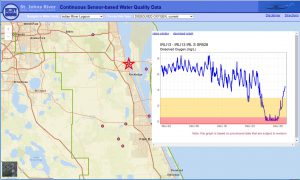By Lisa Krimsky and Holly Abeels
Reports of localized fish kills in the Indian River Lagoon (IRL) began on Thanksgiving in 2020 and continued for the next few days. The fish kill was most prominent between the SR528 and SR520 Causeways near Cocoa and Merritt Island but extended from Titusville to the Eau Gallie Causeway. The fish kill coincided with a low dissolved oxygen event in the same area with low (below 2-3 mg/l) oxygen concentrations to near zero (anoxic) conditions. Multiple species were impacted including stingrays, catfish, mullet, and needlefish, to name a few.

According to a multi-agency consortium that is collaboratively working to address harmful algal blooms in the IRL, the cause of the low dissolved oxygen event has not yet been determined. A blue-green algae (cyanobacteria) bloom has dominated the IRL since late September. The algae responsible for turning the lagoon pea green was a nanocyanobacteria, possibly of the genus Cyanobium. This super small cyanobacteria is different than the brown tide organism (Aureoumbra langunensis) that was the culprit of the 2016 massive fish kill in the IRL.
Recently, the species composition of the bloom has shifted and has changed the color of the water from green to brown. The nanocyanobacteria is no longer dominant, and instead the bloom consists of a variety of different algae species. With few exceptions, water quality results indicate that the bloom was not toxic and analysis is currently underway for the most recently collected water samples. More algal bloom data and information can be found at https://floridadep.gov/AlgalBloom.
Despite the bloom, the low oxygen event was more likely associated with the die-off and decomposition of a native drift algae, Caulerpa, which naturally dies back after it reproduces. An unpleasant smell associated with the decomposition of the Caulerpa occurred around the same time as the low oxygen event.

Residents and visitors are cautioned not to recreate near fish kills. Fish kills can be reported to the FWC fish kill hotline: https://myfwc.com/research/saltwater/health/fish-kills-hotline/. Residents looking to dispose of fish on private property are encouraged to contact their local governments for guidance. Decomposition of fish can add nutrients to the water column, thereby feeding the algal bloom. However, fishing regulations are still in place so residents should take caution when disposing of regulated species.
All residents are encouraged to help reduce nutrient inputs into the lagoon. Follow fertilizer recommendations and watering guidelines in the home landscape. Prevent grass clippings and leaves from entering canals and storm drains. Reduce the amount of impervious surfaces in your yard. Clean up after your pets. Have your septic systems inspected and pumped out every 3-5 years. For more information on how you can help, go to: https://sfyl.ifas.ufl.edu/brevard
 0
0
